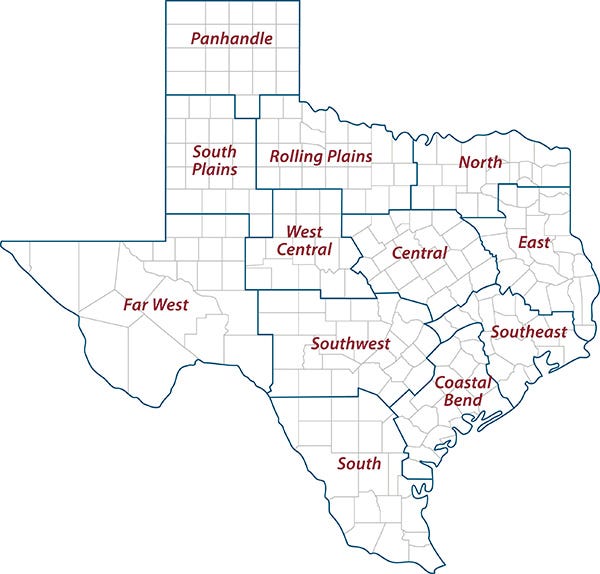
Texas citrus growers had a difficult 2018-2019 growing season, with production down more than 20 percent, according to a Texas A&M AgriLife Extension Service expert.
Dr. Juan Anciso, AgriLife Extension horticulturist, Weslaco, said harvest just wrapped up and a lack of rain, smaller fruit and lower consumer demand made the season one citrus growers hope to forget.
Texas citrus growers produced a bumper 2017-2018 crop, and conditions last May showed promise for strong yields this season, but Mother Nature didn’t cooperate. Conditions turned dry and then wet at inopportune times throughout the season.
“Summer was hard,” he said. “There wasn’t enough rain, and early fruit didn’t size up correctly. So, yields were low, and then demand was down and didn’t seem like there was any positive movement on prices. It was just a tough year.”
Anciso said production last season was up 10 percent to 8.4 million boxes of grapefruit and oranges,7.7 million, during the previous season. Grapefruit makes up about 70 percent of citrus production in Texas, while oranges make up 30 percent.
Texas citrus acreage remained steady at around 28,000 acres, but production fell to 6.7 million boxes this season, more than a 20 percent decline.
“There were a lot of things that contributed to the decline,” he said. “Not enough rain, then it rained, and crews couldn’t get it. Prices weren’t great and yields were down. We’ve seen dips, and we can usually explain those, but this was way off.”
Anciso said weather conditions this spring could indicate a bad 2019-2020 harvest. Cold temperatures during peak bloom in early March may have knocked off considerable fruit sets.
“It got down to 38 degrees Fahrenheit on March 4, which is when bloom is in full swing,” he said. “That’s too cold for those blooms. We’re wanting to be optimistic, but I have already been called out to assess some crop insurance claims.”
Despite some difficult years, Anciso said Texas’ citrus industry has been profitable over the last decade.
“We do get painful years. We went from a bumper crop to not very good yields,” he said. “Things took a turn, but that is agriculture. And no one is surprised because, like everyone, we rely on weather, yields, and supply and demand. We’re just hoping next year will deliver a good crop and good prices.”
AgriLife Extension district reporters compiled the following summaries:

CENTRAL: Daytime temperatures were into the mid- to upper-90s with high humidity. The district received a little more rainfall, with heavy rains in a few areas. Producers looked for a few dry days in a row to get hay cut and baled. Corn for silage looked good in most locations, and producers will begin harvest in the next two weeks. Fieldwork was limited in most areas, but producers were able to get fertilizer on Coastal Bermuda grass pastures. Cotton and sorghum were fair in some areas, but conditions were not good in other areas due to excessive rain. Livestock were in good condition. Fields were growing well. Hay and forage producers expect a good year as long as pastures can dry between cuttings. Wheat harvest neared completion. Cotton was progressing. Thrips and flea hoppers were an issue. Nearly all counties reported adequate soil moisture. Overall rangeland, pasture and crop conditions were good in nearly all counties.
ROLLING PLAINS: Conditions were warm and windy with more rain in some areas. Cotton planting picked, but farmers were still not able to plant wet areas in fields. Wheat harvest was coming along. Weather damage was common in many fields. Pastures were in great condition. Some cattle producers were having a hard time fighting pest insects.
COASTAL BEND: A large portion of the district received much-needed rain. Most subsoil and topsoil moisture conditions were adequate. Crops were in good condition and progressing well. Sorghum harvest should begin soon. Cotton was in full bloom in most fields. High corn yields were expected over most of the district. The exceptions were DeWitt County, where the lack of mid- to late-May rain was expected to diminish corn yields, and Jackson County, where wild pigs destroyed corn in some areas. Pasture and rangeland conditions were good. Hay harvesting was in full swing with heavy yields reported. Livestock were in good condition. Pecan producers were applying fungicides.
EAST: The district received widespread rainfall, as much as 6 inches in some areas. Houston County reported some producers were able to bale hay before the rain hit, while others left cuttings on the ground. Producers in several counties were waiting for a break in the showers to cut and bale. Ponds were full, and grass was abundant. Pasture and rangelands were in good condition. Subsoil and topsoil remained adequate. Livestock were in good condition. Fly numbers were high in Henderson County. Wild pigs caused major damages across Sabine County.
SOUTH PLAINS: Subsoil and topsoil moisture levels were short to adequate depending on rain amounts. Producers expect rapid drying as temperatures continue to rise. Many cotton fields were lost to storms and extensive hail. Fields were being replanted with sorghum or corn. Pastures, rangeland and winter wheat were in fair to good condition. Wheat harvest began. Producers were finishing up planting and working on weed control. Cattle were in good condition.
PANHANDLE: Producers were preparing for wheat harvest with some dryland harvest already underway. Expectations were for a high crop yield. Corn stages ranged from the second leaf to the eighth, so variability was high across the district. Moth traps showed increased numbers of southwest corn borers. Cotton acres were crashing due to inclement weather events. Some crops were lost due to bailouts, blowouts on young plants and seedling diseases caused by excessive rain. As much as 60 percent of the cotton crop on Randall County was lost. Producers were planting sorghum or short-season corn to replace failed cotton acres. Rangelands and pastures were in excellent condition with all the moisture.
NORTH: Soil moisture was mostly adequate across the district. Heavy rains fell across most parts of the district with counties reporting from 2-5 inches. Collin County reported golf ball- and baseball-sized hail in some areas of the county. Many producers on drier lands were working hard to harvest winter wheat before the rain. Hay producers were getting hay out when possible, but many pastures were still uncut due to sporadic thunderstorms. Corn looked good. Wheat and oat harvests were 80 percent complete as producers deal with limited access to fields. Wheat yields were above average with 60-70 bushels per acre. Oat fields were producing around 80 bushels per acre. Spring calving was complete and cattle looked good. Wild pigs were active.
FAR WEST: Average high temperature was 107 degrees with lows around 70 degrees. Many thunderstorms were spotted, but areas received trace amounts on average. High winds and temperatures were causing soil moisture to dry out. Winter wheat and oats were baled or completely grazed down. Cotton farmers reported very few plants emerging. Pastures were in good condition, but insects were progressively worsening. Pecan trees needed water to maintain nut sets. Livestock and rangeland conditions were fair. Lambs and goats continued to be shipped.
WEST CENTRAL: Field conditions were good to plant cotton and harvest wheat. Most cotton was planted, but there was still some wheat to get out. There was a little rain that slowed work down, but 100-degree days came late in the reporting period. Hail caused some damage to cotton and trees in parts of the district. Grain crops looked good. Pastures were in great shape. Stocker steers and heifers in good condition sold steadily. Fleshy calves weighing 500-800 pounds were $5-$7 lower per hundredweight. Feeder steers and heifers were $5 lower per hundredweight. Packer cows were $1-$2 lower per hundredweight, and bulls were $2 lower. Bred cows and pairs were steady with good demand.
SOUTHEAST: The weather was good and a lot of hay was baled. Brazos County reported heavy rain. Lee County received some rain. Temperatures were rising. Rangeland and pasture ratings were poor to excellent with good being most common. Soil-moisture levels were adequate to surplus with adequate being most common.
SOUTHWEST: More rain was received in some counties. Sorghum in some fields was beginning to lean due to heavy weight at the top in combination with moist soil and blowing wind. This will make it difficult to harvest. Corn continued to do well thanks to recent rains. There were reports of great hay yields. Rangelands and pastures were in great shape. Livestock were doing well, and grazing conditions were good to excellent.
SOUTH: No report.
Source: is AgriLife TODAY, which is solely responsible for the information provided and is wholly owned by the source. Informa Business Media and all its subsidiaries are not responsible for any of the content contained in this information asset.
About the Author(s)
You May Also Like




